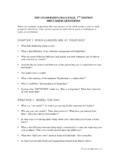Transcription of The new case for shared services - EY
1 Growth fueling challengesThe new case for shared services The dramatic rise in unconventional production is certainly one of the most compelling success stories in the energy or oil and gas industry s recent history. The oil and gas industry is enjoying an unprecedented growth cycle that is likely to continue for many years. But that growth brings capital, cost and capacity challenges that can be overcome by changing the way services are delivered dramatic rise in unconventional production is certainly one ofthe most compelling success stories in the energy industry s recenthistory. The rush to develop tight oil, oil sands and other unconventionals has increased North American liquids supply to levels not seen since the 1980s, and the trend is expected to continue well into the that success comes with new and unique challenges.
2 The growth in crude production, coupled with the extended global recession, has pushed the price of oil down to a range of US$90 to US$110 per barrel, tightening margins. At the same time, the need for cash continues to rise, from capital requirements to back-offi ce expenses, with most related to the boom in shale new case for shared servicesThe situation is much the same for downstream companies. Many face expensive capital requirements to upgrade aging facilities and provide a refi ning outlet for increased production of light crude. In addition to these margin and capital challenges is the fact that the industry s workforce is aging and a signifi cant talent shortage is impacting performance in key innovation and technology advances that have spurred a new energy renaissance in North America have left many companies struggling to manage growth.
3 There is a very real need for sustained cost reduction and system scalability to accommodate continued increases in activity. A key challenge for energy companies today is to identify structural, long-term organizational changes that can strengthen their ability to compete in a low-margin/high-capital capital growth innovation and technology advances that have spurred a new energy renaissance in North America have left many companies struggling to manage new case for shared services |To remain competitive, energy companies today need to maximize cash from operations. They can achieve this in large part by lowering back-offi ce costs, but this must be done without negatively impacting addition, it will be critical for companies to keep the rate of increase of future costs below that of their revenue growth.
4 And they must have adaptive cost structures in order to fl ex with constant, unanticipated change. What needs to changeIn other words, companies must fi nd a workable balance between staffi ng, costs and a high level of service for back-offi ce operations. To achieve this balance, companies have several talent and cost levers they can use, including: Knowledge management Workforce specialization Labor arbitrageKnowledge managementWorkforce specializationLabor arbitrageProcess improvementProcess standardizationProcess automationCost level Cost fl exibility Cost scalability Workforce sustainability Workforce fl exibility Service level Service fl exibility Service scalability Service sustainability The following chart visually maps the goals and available levers.
5 Process improvement Process standardization Process automationIt will be critical for companies to keep the rate of increase of future costs below that of their revenue | EYGM LimitedChoosing the right operating modelMaximizing the potential of shared servicesThere are pros and cons to each of the various models for delivering back-offi ce services outsourcing, captive shared services or hybrid , many organizations have learned that in order for outsourcing to be an effective solution, a highly functional internal governance model is required. And once that mature model is in place, companies could enjoy the benefi ts of outsourcing cost and effi ciency while using a captive shared services approach that also enabled fl , there has been a trend toward insourcing among energy companies, allowing organizations to save the margins they previously passed on to their outsourcing partners.
6 Given today s constraints, both established super-majors and start-ups alike should take a fresh look at shared services to help them realize their cost management , shared service organizations have underperformed for many oil and gas companies, for a number of reasons. Thus, discussion of expanding these operations into new geographies and new, more complex functions such as budgeting, planning and analysis is often met with skepticism. But there is a great deal of value to be gained by fi xing and optimizing existing shared service operations, and then transitioning to new functions. Doing so, of course, requires understanding what is currently not working, and then designing and implementing corrective actions.
7 Issues that companies need to consider and address include:Leadership support Is company leadership tangibly supporting shared services ? If executive leadership does not mandate shared services and allows an opt-in approach, many predictable events negatively impacting performance often follow. Functional leaders may agree to migrate certain activities to shared services but may only agree to do so as long as they can maintain control and exclusively determine the defi nition of success of shared services . A better formula for success is to agree upon which activities will be migrated, based on leading-practice criteria, and agreeing on a standard delivery model, along with a cross-functional RACI ( , who s Responsible, Accountable, Consulted, and Informed for each management activity) agreement.
8 In short, a standard delivery model is needed. The minute functional leaders are allowed to negotiate changes to the standard model, future success is Typically, the biggest branding mistake when it comes to shared services is NOT branding. Without effective branding, stakeholders are free to rely on their preconceived notions of what shared services is or should be. Proactively branding the organization as a leader in global collaboration or as an innovation center can have a positive effect. Brand drives culture and culture drives new case for shared services |Governance Allowing your shared services governance organization to be structured as a one-way, top-down oversight organization specifi cally focused on shared services improvements is a very common mistake that can result in missed improvement opportunities, negativity and morale and retention problems.
9 Frequently, performance problems originate within the shared services ecosystem, but outside of the shared services organization s control. Examples include: HR employee requisition and approval policies result in continual understaffi ng of the centers. IT infrastructure results in slow and unreliable system response, thus handicapping productivity. Facilities sharing policies, if not well communicated and executed, can result in second-class treatment for center personnel, placing a drag on morale. Internal corporate process owners place external customer contact constraints or approval requirements upon the center, but don t keep the work fl owing by performing these additional intermediary steps they have governance takes an arm s length view of the entire shared service ecosystem, including the enabling organizations that provide service to the shared service organization as well as their customers.
10 Further, the governance organization should demand performance accountability wherever there are performance gaps, across the entire ecosystem. Governance should be both an advocate and a critic for all stakeholders. Ongoing, proactive, multidimensional, effective risk assessments should be incorporated into the governance governance has to be designed. In addition to councils and accountability documents, there are many processes that should be designed and management shared service organizations are often burdened with unrealistic expectations. Internal customers do not want to accept a drop-off in performance during the migration period, specifi cally when knowledge transfer and new employee training is taking place, and where an infrastructure may not be , customers commonly demand a performance level that has never been measured or achieved in the legacy organization.

















